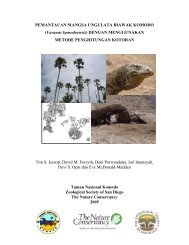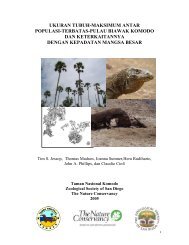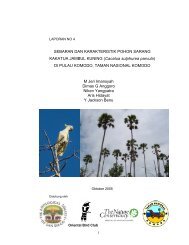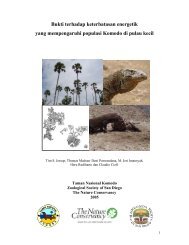Sustainable Financing of MPAs - Komodo National Park
Sustainable Financing of MPAs - Komodo National Park
Sustainable Financing of MPAs - Komodo National Park
Create successful ePaper yourself
Turn your PDF publications into a flip-book with our unique Google optimized e-Paper software.
3 Case study: <strong>Komodo</strong> <strong>National</strong> <strong>Park</strong><br />
<strong>Komodo</strong> <strong>National</strong> <strong>Park</strong> is located in the southeast part <strong>of</strong> the Indonesian archipelago,<br />
between the islands <strong>of</strong> Sumbawa and Flores. <strong>Komodo</strong> <strong>National</strong> <strong>Park</strong> includes three major<br />
islands: <strong>Komodo</strong>, Rinca and Padar, as well as numerous smaller islands creating a total surface<br />
area <strong>of</strong> 1,817 km 2 (marine and land). The total population currently living in the <strong>Park</strong> is 3,267<br />
people spread out over four settlements, whilst 16,816 people live in the area immediately<br />
surrounding the <strong>Park</strong>. The majority are fishermen. (<strong>Komodo</strong> <strong>National</strong> <strong>Park</strong> 2005)<br />
Established in 1980, <strong>Komodo</strong> <strong>National</strong> <strong>Park</strong> is declared a World Heritage Site and a Man<br />
and Biosphere Reserve by UNESCO in 1986. <strong>Komodo</strong> is known for the endangered <strong>Komodo</strong><br />
dragon and contains an important marine reserve with more than 1,000 species <strong>of</strong> tropical fish,<br />
invertebrates and mammals. (World Heritage 2005)<br />
The goal <strong>of</strong> <strong>Komodo</strong> <strong>National</strong> <strong>Park</strong> is to protect its biodiversity, particularly the <strong>Komodo</strong><br />
dragon. Specifically for the marine component the objective is to protect the breeding stocks<br />
<strong>of</strong> commercial fishes for replenishment <strong>of</strong> surrounding fishing grounds (Subijanto 2002). The<br />
park has a significant recreational value and receives 20,000-25,000 visitors per year (TNC<br />
2004, 16).<br />
Figure 1: Map <strong>of</strong> <strong>Komodo</strong> <strong>National</strong> <strong>Park</strong>. (Dive The World 2004)<br />
14






